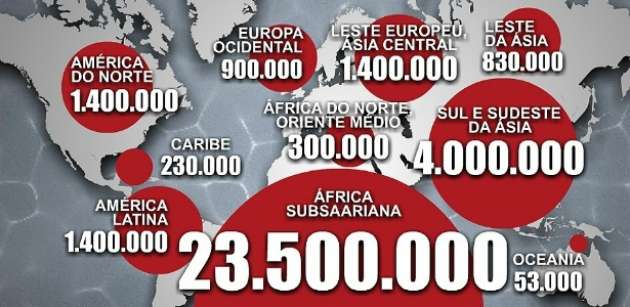Sub-Saharan Africa is the political-geographical term applied to describe the countries of the African continent located in the region south of the Sahara desert.
It is one of the poorest regions in the world with high rates of infant mortality, illiteracy and low life expectancy.
countries

Sub-Saharan Africa is made up of the following countries:
- South Africa
- Angola
- benin
- Botswana
- Burkina Faso
- Burundi
- Cameroon
- Cape Green
- Chad
- Congo
- Costa do Marfim
- Djibouti
- Equatorial Guinea
- Eritrea
- Ethiopia
- Gabon
- Gambia
- Ghana
- guinea
- Guinea Bissau
- Comoros Islands
- Lesotho
- Liberia
- Madagascar
- Malawi
- mali
- Mauritania
- Mauritius
- Mozambique
- Namibia
- Niger
- Nigeria
- Kenya
- Central African Republic
- Rwanda
- Democratic Republic of Congo
- Sao Tome and Principe
- Senegal
- Seychelles
- Sierra Leone
- Somalia
- Sudan
- Swaziland
- Tanzania
- Togo
- Uganda
- Zambia
- Zimbabwe
Population
World Bank data indicate that this is the poorest region on the planet. At least 37% of the population of 973.4 million people live in urban areas. The income per capita is US$1,638 and life expectancy at birth is 58 years.
To understand the difference, let's compare these data with those from Brazil. According to the World Bank, the life expectancy of Brazilians at birth is 74 years and the per capita income reaches US$ 11,530.
33 of the 43 countries with the lowest HDI are located in this region, making poverty almost endemic.
Economy
O extractivism it is the main source of income in sub-Saharan Africa. This piece of the African continent holds 7% of the world's oil reserves and important reserves of phosphate, copper and cobalt.
Tourism is also a growing industry, as Tanzania's beaches and Kenya's nature reserves, for example, attract European and American tourists.
Sub-Saharan Africa has been receiving heavy investments from the Chinese in search of securing raw materials and, above all, land to feed its population.
The region experienced incredible growth in the first decades of the 21st century due to the increase in raw material exports.
History

Sub-Saharan Africa is considered the cradle of the human race, as the genus emerged in the region called East Africa Homo. The evidence is in tools collected by archaeologists and marks the beginning of the Paleolithic.
The region was also home to large kingdoms such as Mali (XIII-XVI), which monopolized the salt trade. This allowed them to market the product through the trans-Saharan routes and obtain products in iron, horses and china.
As it was an Islamic kingdom, several mosques were erected and, today, the temples of Timbuktu have been declared a World Heritage Site.
geography
The most stable terrain on Earth is in Africa. The continent has remained in the same position for about 550 million years and most of it is made up of a huge plateau.
Near the tropic of Ecuador there is an area with tropical rainforests, to the south is the savannah that occupies most of sub-Saharan Africa.
Also to the south is the Kalahari desert, which extends to the coast of the Atlantic Ocean.
Climate
The climate is influenced by Ecuador, although there are temperate microclimates in the highlands. The region is rainy and with rainfall typical of humid forests.
Since the last Ice Age, there has been a climate-imposed separation between the North and the Sub-Saharan Regions. The severity of the weather is interrupted only by the Nilo river.
Sub-Saharan Africa, compared to northern Sahara, was isolated and not influenced by Arab culture and Islam.
Geology
The rocks typical of this region solidified during the Earth's first eruption cycles and today represent the largest source of the economy, based on gold and diamond mining. The region is also rich in copper and chromium.
language and religion
There are at least 600 languages spoken in sub-Saharan Africa, most of which originate in Bantu. There is also the influence of European colonization and, therefore, there are nations that speak Portuguese, French and English.
Most countries are Christian, concentrating 21% of Christians worldwide. However, there is a large portion of Muslims and countries, such as Nigeria, where the population is practically divided between the two faiths.
There are also those who practice traditional African animist religions.
AIDS

In addition to extreme poverty, which mainly affects countries plagued by constant civil wars, Africa suffers from a pandemic of AIDS that devastates the region.
The productive capacity of countries has been put in check due to the huge number of orphans of parents who die very young due to the consequences of the disease.
THE South Africa, for example, has 4 million orphans due to the epidemic. In Malawi, the scene is repeated and several children and teenagers are already heads of families.
Among the justifications for the contamination rate is sexual exploitation and the treatment given to women, who are considered inferior.
read more:
- North Africa
- African culture
- famine in africa
- Decolonization of Africa
- Precolonial Africa
- Refugees


